#charater design analysis
Text
I know some people like to joke haha the girl workers get funny peg legs but something interesting idk if anyone’s pointed it out (probably, it’s fairly obvious) is that V and J both have different peg legs
J’s are only halfway done, and amusingly don’t have the yellow caution on them at the end like V’s, since they only go halfway with little black pieces in the front
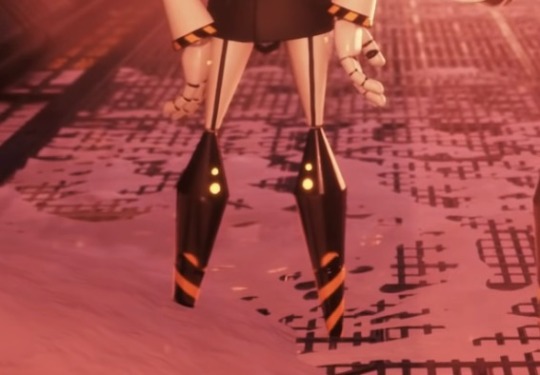
Meanwhile V has fully black legs along with the yellow caution, leaving space for the white bits at the end though

Which i feel like implies V can do something with her legs idk what but something! Maybe she can change out her limbs like her hands since its the same type of caution. Also heres the full image i used for reference
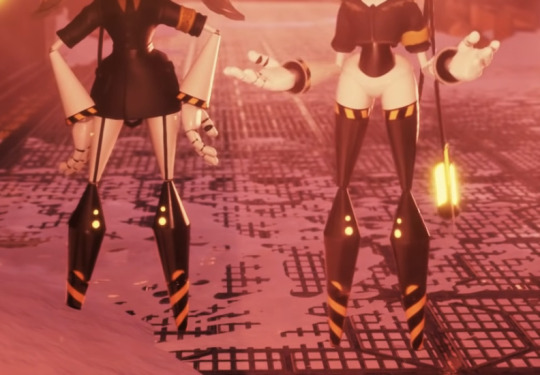
And yeah i just thought it was interesting character design and might mean v can detach her legs or something idk.
and it also fuels my hc (copy pasted from my rambles): I have a hc about that!! Basically no two disassembly drone are the same (since J has slightly different legs than V) so they all have different leg/feet designs to do different things! Peg legs for stabbing enemies, regular feet for distance, biped legs for faster running, claw/raptor feet for climbing..etc!
57 notes
·
View notes
Text
Has Genshin Impact lost its way with narrative character designs? Critique and Praise
I like simple yet unique and memorable visuals in storytelling. I think this goes for my taste in any form of visual art: graphic design, video editing, illustration…
Has Genshin Impact lost its way with narrative character designs?
The outfits keep on getting more and more detailed and complicated with each character but I don’t feel much looking at them. From Inazuma onwards, at a glance, it all just seem like just another sparkly anime character design (especially for the female characters) instead of something unique that conveys the character’s personality to me.

Are the designers at HoYoverse too focused on making them marketable in a Gacha game rather than making sure their designs convey their personality effectively? Are they aiming for more and more complex character designs while forgetting the aesthetics, themes, and storyline that ties them all together for each region?
This is another reason why I lost my interest significantly after Inazuma’s release.


For this reason I personally feel Albedo, Barbara, Diluc, Rosaria, and Venti have some of the most memorable character designs amongst the Mondstadt cast, dare I say even amongst all the playable characters released. (Of course it’s also influenced by my personal tastes in character designs.)
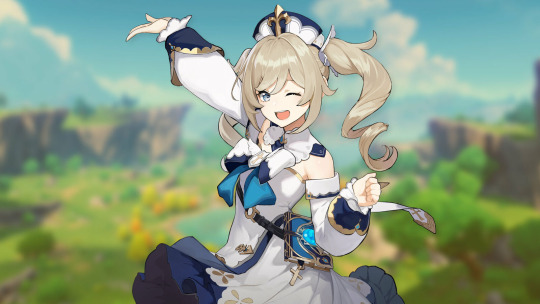
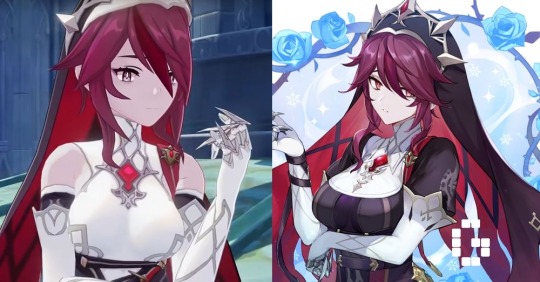
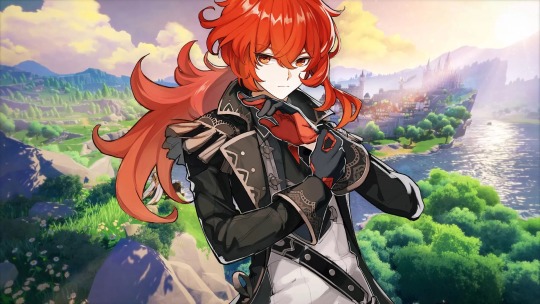
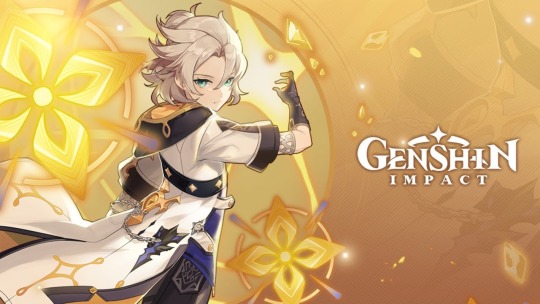
They’re simple and not very flashy, so attention goes to their face, which is where you should be looking at first in a character design most of the time.
The use of black and white in them (or navy and white for Barbara) only brings out their face and defining assesories plus key colours even more. Their clothes are not outstanding with the muted colours. Blue, magenta, red, and gold are the respective “character colours” that pop out for Barbara, Rosaria, Diluc, and Albedo. Blue for gentleness and kindness, magenta for aloofness and mystery, red for resolve and individuality, and gold for elegance and perhaps prestige. These are all first impressions one might have towards them.

As for Venti, his colour palette is very pleasing and it’s obvious that green is the main colour with shades of beige, white, and gold being details. Pops of cyan in his eyes and “Vision” cools down the design and makes it look refreshing. His colours are in the mid-range in value, so giving him dark navy hair draws attention to his face immediately. A good design for a carefree wind god. You look at him, and he seems like just a little boy, if not somewhat androgynous.
I miss the Mondstadt times, where the storyline is simple enough that the characters feel familiar and welcoming.
#dusk analysis#Genshin impact#charater design#analysis#anime character design#character design analysis#design analysis#Diluc#Barbara#albedo#Rosaria#diluc ragnvindr#albedo kreideprinz#barbara pegg#Liyue#Mondtadt#Inazuma#game critique
72 notes
·
View notes
Text
Am I about to do a charater analysis of every Owl House character? Yes, yes I am.
Just saw a Tik Tok edit about The Owl House Villians and it got me thinking, some of the characters are much more complex than villains. In fact, the show has types of characters that aren't always shown in children cartoons. The most common characters we do see are heroes, villains, and/or twist villains. If we're lucky we get tragic antiheroes. But the show has other character types that I don't always see in Disney cartoons. And I'm gonna talk about every single charater and what type of charater they are!!! Look, the hiatus as me going insane, ok?
The twist hero. A character that appears to be the villain but turns out to be the hero. The opposite of a twist villain. The edit had Darius as the villain and yes, he did start off in a very villainous light. His behavior was snooty, cold hearted, cruel, sinister and he was mean to our heroes. His design looks threatening as well. Has anyone noticed how Darius transformation is a parallel to Belos transformation? Piles of goop and can turn their limbs into weapons. Heck, they had him in that famous Disney Villain Green.

But then, it turns out all his villainous deeds were actually heroic ones. He didn't kidnap Raine and their team, he saved them from being locked away forever. He wasn't being a jerk to Eberwolf, that's their sibling like relationship. He wasn't gonna force Willow and her friends into the coven, he was just returning them without attracting attention!! He wasn't trying to be a jerk to Hunter, he was trying to push him onto the right track.
And back to that Belos and Darius parallel!!! It just hit me!!! Darius was shown in a green light and the green light means villain. While Belos was shown in a golden light, and in Disney gold means hero. Then when we have their transformations. Piles of goop that can turn their limbs into weapons. They both have the same powers but there's a main difference. Darius has better control over his powers and he embraces it. Belos has zero control and is continually trying to suppress it with palisman magic. And then we have their personalities!!! Darius is open about his opinions and wears his emotions on his sleeve. If he doesn't like you, he'll say it. He comes off as a jerk but at least you know where you stand with him. As for Belos, this guy uses pretty words. He's always so calm and well put together. A man of the law and justice. But it's not real, he's suppressing his anger and thoughts. He's hiding what the public would note as uncivilized.
What I'm saying is, all these details and characteristics are what made the twist hero so much better. We're used to that Disney image of a hero and that Disney image of a villain that we didn't see it coming. And I adore that. I don't think we ever had a twist hero in a Disney cartoon before. If we have, please tell me. And no, a villain who had redemption doesn't count as a twist hero. They have to have been the good guy the whole time for them to be a twist hero. Honestly, the closest I can think of is Ducktales. Lena and Penny aren't twist heros, they were more antagonist who saw what was right and wrong. So the next one I can think of is Gandra. She was never evil and was working with Fenton.
I'll be posting about the other characters on a separate post. I'm looking forward to writing about Kiki and Terra.
#the owl house#owl house#darius toh#the owl house belos#the owl house darius#i was ginna bring up race and homosexualilty as well#how disney villainous a lot of gay coded characters#and people of color as well#BUT#thats sensitive territory right there#so yeah#I don't want to mess up there
66 notes
·
View notes
Text
i think its funny comparing how i became obsessed with certain charaters because with mizuki i found their story and arc extremely relatable, quickly falling love with them mostly because of that, not to mention a trans character will always steal my heart and i find her design adorable, this is a character i could write character analysis for days on end but i dont draw them much
and then theres ena who just hit me like a train one day out of nowhere and i never recovered. i have no idea what exactly made me love her so much, at first i found her design boring compared to others and dint find her all that interesting, especially since i was more focused on mizuki, and yet the next thing i know shes my fav and i will defend her till i die. i dont have any coherent thoughts about her tho its all just AAAHHHH MY LITTLE POOKIEEE ENA SHINONOME I LOVE YOU YOU ARE SO PRETTY AND KIND AND STUBBORN AND MEAN AND CARING AND I LOVE YOU I NEED TO DRAW YOU EVERY DAY OF MY LIFE
i do however wanna try and put my ena thoughts out there sometime in some coherent way because i think about her more than i play the damn game she is my everything
6 notes
·
View notes
Note
I was gonna say Spamton but u tagged dc so u get Music Meister
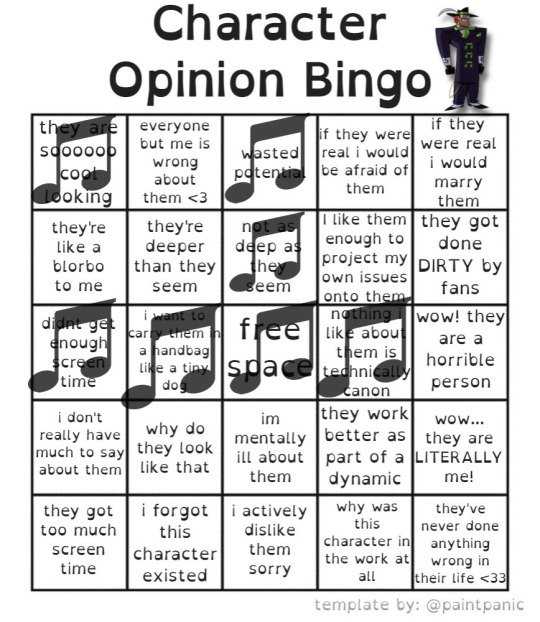
Template by @/paintpanic
Because I like talking, I’ll clarify! For funsies! (Also, I’m sorry Karp I know he’s your favorite but I have some things to say…)
I love Music Meisters design a lot despite it being a repeat of the purple and green color scheme. Super fun and SUPER creative. I’m also a SUCKER for these types of designs so.
Oh my god I feel like they could have done so much more with him but I don’t quite know what. I’m trying to delve more into that with my own Music Meister but it’s really difficult.
He’s got something but the vague backstory we got in Brave and the Bold? I don’t know if that’s enough to say “deep”?
Did not have enough time on screen. Straight up. I mean he got an episode but like- go in MOREEEEE. I WANNA KNOW WHERE HE GOT HIS COOL MUSIC POWERS.
Free space, so ramble. More episodes with him. More content with him. Expand on him. He’s a theater kid. I’m also super bias, I’m sorry 😭. I think he would be SOOOO FUN dude. I like a fun goofy guy and he’s no exception ✨. He doesn’t need to be a super sad charater even, I love a fun guy honestly.
There’s things I like about him that are canon, but a lot of the fleshed out lore of MM has mostly just come from fans analysis and HCs.
16 notes
·
View notes
Text
✨Nina Gregier✨ Inspiration for my lino pattern

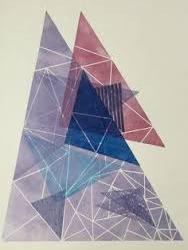


Nina is a graphic designer and an art director who focuses on things like typography, branding and print design. As you can see In the images above Nina uses a lot of complimentary cool toned colours as well as a layering which inspired me to create a design very similar to hers on my final apron design
There is little detail to whether Nina created this work via graphical or printmaking. Therefore for the sake of my analysis i am going to assume it is a printaking process, so the process will be very similar to the work we done in our workshop. (you can find the full lino print process on my page)
So whilst i was fguring out my plan to design a geometric themed apron, i took into account the positioning, colours and type of patterns/shapes.
Starting off with color palette: Evidentally Nina uses complimentary, cool colours ie. purples and blues. Taking this into account whilst creating a design process. I started off with blue and purple colours as a foundation for my layering process, but i then decided that incorporating contrasting colours would form a focal point to my design thats located on one area of my apron so i added a bright yellow to capture the eye and a deep green colour to add a bit of variety as well as a fulfilling element.
Layering: I think the layering technique is effective because it adapts something so simple and turns it into an art piece with characteristics, each design separated has a different elment whether its the colour or pattern within the triangular structures.But on the other hand i see this layering technique in effective with regards to my task, it looks great with regards to Nina's piece because she has filled the paper and minimalised the negative spaces but with my piece, recreating this design would be overwhelmed by the amount of negative space. Therefore i adapted Nina's by creating multiple,smaller areas which overlapped in order to fill more of my targetted area. Once i completed overlapping certain areas, thre was still a lot of negative space that i wanted to fill so i added single layered triangles to finalize my design.
The lines inside of the triangles: Nina likes to add charater to each of the triangle printmakingstencils. On one hand i think this is effective and it helps enhance the layering and advances the design. But on the other hand i think its ineffective because it doesn't add much variety nor excitement to the piece if she added different shapes within the triangles i believe it would have made the piece even more exciting and show off more the skills that she has. therefori looked at other ways that i could add what i think was absent in Nina's work, adding triangles, grids, horizontal lines and een leaving some plain. This helped make my final piece a demonstration of my creative skills as well as my technical skills.
In the future if i were to do lino print again i would like to try and improve my applying technique because on paper its a lot easier to apply and the outcome looks more even and clean but when doing lino printing on fabric the design looks more fuzzy and when the stencil is applied to the fabric, the paint is harder to transfer onto the fabric so next time i will use a clen roller to roll on top of the stencil to help spread the paint across the design evenly
1 note
·
View note
Text

Ahoy there! (LONG POST WARNING, SORRY)
So, a few weeks back I posted some doodles of some reimagined classic Zelda enemies ( https://reefs-n-reilly.tumblr.com/post/187779770611/recently-did-a-doodling-project-of-adapting-some ), and that kinda evolved into a whole project idea for what’d I’d do if I had the reigns for a new mainline Zelda game.
Introducing: The Legend of Zelda: Shadows’ Requiem!
Often in Zelda games there’s a point where the player learns the tale of a brave hero from the past who defeated some great evil. This is shown in TLoZ: BoTW via tapestry depicting Zelda and Link fighting Ganon while surrounded by guardians, and in Wind Waker the story is told to the player in the first cutscene, and is further referenced when Link becomes the age of the legendary hero and begrudgingly dons the iconic tunic as is the tradition in that world. What if those stories passed down had a larger impact in the game universe though? Shadows’ Requiem takes place in a post-Ganon Hyrule. While the world continues to be rebuiltand heal even 100 years after Ganon’s defeat, the stories of the prior hero’s glory reach far and wide and impact many, including a child who lives in the same village as the player.
The “Link” depicted in my doodle isn’t Link, but the player’s neighbor from the starting village who was beaten over the head with the importance of “The Hero” and being like “The Hero” by his parents, and believes himself to be the reincarnation of the hero reborn. He ferverously studies stories and anecdotes about every detail of the old hero in an attempt to be like him and gain his greatness. As the story progresses though it becomes more and more apparent, both to himself and the player, that he is not the hero reborn which culminates in his “time skip” appearance and title of “Shadow of the Hero” where he clutches to his stolen identity, symbolized though his use of the master sword still in it’s stone which causes him to weild it improperly and bleed because he refuses to let go, even to the point of attacking the player in defense (“You can’t take this (referring to the master sword and his identity as Link/the hero reborn) away from me. I AM THE HERO...I won’t let you destroy that, I won’t let you destroy me!” *battle commences*). The whole point of the charater is a new take on Dark Link and an analysis of who Link is and what it means to be a “hero.” The child wants the glory, the fame and adoration, but is blinded to the reasons for why Link’s story is passed on and why people like him. Link/the Hero never wanted or even cared about the glory, he just wanted to be helpful to others, meet the beautiful cultures and people in his world, and do the right thing in the face of Ganon’s evil.
The game’s call to action occurs when a warlord named Aghanim (psst, @tyrantchimera , notice any familiar details in the Aghanim doodle that might reveal his true dentity? ;} ) suddenly grows in power and begins invading villages in a conquest to resurrect Ganon, hence the bottom-right propaganda doodle which depicts him with Ganon’s face (he is not Ganon in this game). Naturally, the “hero” child sets out to stop Aghanim and his dark forces, and eventually the player follows in the “hero” child’s wake, cleaning up after him as they progress through the story. Many villages are left in a rough condition as the shadow of the hero has rampaged through, taking advantage of the villager’s hospitality and ignoring those who may truly need him in favor of more “profitable” or noticable deeds. The actions of the player gain the attention of Zelda, who has also been cleaning after the “hero’s” mess while simultaneously running a rebellious vigilante group against Aghanim under the alter-ego “Shiek.”
Speaking of Zelda, next to the doodle of the child is “Zelda’s Z-Targeting.” In this game, Zelda would function as the player’s companion in a similar way to Midna or Navi from past games. During battle, she would move around the area and assist the player using items assigned to her to fight in various ways. This is a whole system I could detail, but to summarize in an example: the player equipping the bow can aiming and shoot limited arrows from a quiver as fast as they can fire, but Zelda holding the bow means that the press of a button while targeting an enemy or object causes Zelda to turn a nearby object (E.g. a stick on the ground) into a magical flaming arrow which she fires at the target. Zelda would require a cooldown, but she has more strength, infinite ammo, and allows the player to utilize another weapon at the same time. This system would allow for fun fighting styles based on your weapon combinations, and could also be used supportively by giving Zelda items like potions so the player does not have to pause and disrupt the flow of a battle to heal.
That’s about it for the set of doodles and ideas I think. The appearance of the Zora race is based on a combination of scaridae/parrotfish and mola mola/ocean sunfish, and their war mask appearance is based on the stargazer fish. The females of the Zora race are MUCH bigger, so their warriors are primarliy a valkyrie force. As for the fairy design, it’s based on the classic ball-shaped fairy while trying to give off a fae/pixie feel as well, with a bottom that somewhat parallels the bottom half of Aghanim. The “hair” on the fairy’s head is actually just the remaining light from the prior position of the glowing head.
Apologies for the long post, this is something I’ve been pretty passionate about and thinking of for a little while now, and that’s pretty rare for me so I figured it’d be worth making a bit of a long post for. Odds are good that nothing more will come from any of this though so no worries about future long posts any time soon, lol.
Thank you very much for reading, and here’s hopin’ you’re havin’ a good one and enjoy the rest of your day/night!
#zelda#the legend of zelda#tloz#zelda oc#dark link#aghanim#fairy#zora#ganon#young link#link#hylian shield#master sword#long post#ive wasted so much time dammit
4 notes
·
View notes
Text
"Within Reason" + About the Mod
"Hey Tam! What does 'within reason' mean?"
Hey exposition voice! Great question! I talk about a lot of topics, and have in the past. And there are some things I don't shy away from, and some things I prefer to leave up to others and for me to “stay in my lane.” So... let's go through that.
I think the first thing you need to know is who I am as a person. Not in the sense of making friends, but to understand who I am as the person writing analysis and as a person giving out information. So... here you are...
20.y.o., usa, feminine nb, bisexual, Jewish-ish (I promise I’m going to explain this), personal experience with mental illness
Awesome. Love this rundown. Let’s have a serious chat about this.
(I have a list at the bottom of the “within reason” guidelines, so you can skip the explanations if you want. But I thought they were important, regardless.)
I’m Twenty (20). And I live in the USA.
I’m a young adult. I was born in the 90’s. I remember VHS. And yes, to some people (*cough* my sister *cough*) that may seem pretty old. But here’s where being 20 comes in... I didn’t live through the AIDs epidemic. I wasn’t there. I wasn’t there in the 80s, I wasn’t there to personally experience the national zeitgeist, the political climate, the social climate, etc. I wasn’t there and don’t have my own first-hand accounts of this information.
Now, what I do have is first-hand accounts of the epidemic from people I know (Trusted mentors, professors, friends, etc.) and books/media. But those are not my experiences. I do not have, nor am I, a first-hand account of the AIDS Epidemic.
Feminine NB, Bisexual
Alright, here’s one. I identify as Non-Binary, but I am very much affected by feminine/female/women’s standards in the US. I’m affected and know a great deal about the inter workings of Gender Politics. It also helps that my minor was WGS, which led me to a lot of great resources. And while I no longer study Women, Gender, and Sexuality Studies for college credit, I do study it on my own for my own personal enrichment. I’m also Bisexual, so sexuality politics are prevalent in a lot of my life. Especially with being out.
Jewish-ish
I was not raised Jewish. I was not born Jewish, or half-Jewish. I didn’t grow up in a Jewish household. And as such, I’m not going to even claim that I know what growing up Jewish looks like from personal experience.
What I am going to say... is that I identify heavily with Jewish culture and beliefs. And this is not me asking for a “free pass” to talk about Judaism as a goyim.
This is what I’ll say... I’ve studied Judaism in many settings, explored Judaism heavily in many different aspects, gone to services at my local Synagogue, and fully intended to convert* (there are reasons I haven’t been able to yet, primarily health.) I have Jewish family that I am close with as well that were not part of my immediate family growing up. I love talking with my Jewish friends about identity and sociopolitical issues. I found Judaism later in life.
So what does this mean? It means that I’d like to be able to give myself some credibility for some topics regarding Judaism, Jewish tradition, and Jewish identity, BUT it doesn’t mean I’m an Absolute authority on it.
I am always going to listen to and respect the Jewish community’s perspectives, first and fore most. I may put out analyses, ideas, hcs, or I might even disagree with an idea, but really, it doesn’t matter, fundamentally. And at the end of the day, it’s the Jewish community’s perspective that matters on subjects regarding their experiences and identity, not mine.
Personal Experience with Mental Illness
Not much to say with this. Only that I understand it in more than just a speculative way, and that while I will talk about it, I will be respectful and open-minded.
TLDR // What all this means for “within reason:”
What I will talk about:
The AIDS Epidemic in a limited capacity. Mostly historically focused.
Sexuality/Sensuality Themes
sfw romantic/sexual/sexuality themes/headcanons
Gender Themes
Jewish/Judaic Themes
Family Dynamics
Relationship Dynamics
Character Headcanons (I’m not going to do actor hcs)
Actor Character Analysis (And Actor Dynamics)
“Show”-Specific Text/Charater Analysis [Show meaning which version of the show, I.e. In Trousers (1979) vs In Trousers (1985) or March of the Falsettos (1981) vs Falsettos Act 1 (1992), etc.]
Differences/Evolution of the Trilogy/Different Runs
Lyrical Themes
Costume Designs
Set/Lighting/Sound
tw content (see list below)
Might even throw in a Fanfiction or Fanart
Light-hearted or takes/Memes that don’t violate my “What I Won’t Talk About Section” or “Basic human Decency”
And more...
( go ahead and send me a message or anon ask, I swear the worst I can do is decline to talk about it )
What I Won’t Talk About
Explicit Sexual Themes (particularly things I personally don’t know much about... so please don’t ask me who “tops,” and especially don’t ask me if it’s Trina because that is not alright with me [because Trina is straight and top/bottom are reserved for the LGBTQ+ community.])
Unnecessary “drama” about specific people (actors or fans) unless there is a harm to others
AIDS jokes. Absolutely not.
Whizzer’s death jokes. I will talk about Whizzer’s death. I will not joke about it.
Jason’s sexuality. I don’t mind talking about Jason’s sexuality as a concept, but I’m really not interested in talking about Jason’s sexuality as a more concrete, explicit thing. See above, but also... I know people have done this in a more-than-speculative way.
Triggering Themes (ALL WILL BE TAGGED as “tw [content]” and NONE will be used excessively/without reason)
Alcoholism ( tw alcoholism )
Smoking ( tw smoking )
Death ( tw death )
Self-harm ( tw self-harm )
Suicide ( tw suicide ) + ( tw death )
Homophobia (tw homophobia ) [Never promoting it. Only to talk about social/political climate.]
Anti-Semitism ( tw anti-semitism ) [ALSO Never Promoting it and Only to talk about social/political climate.]
-> Please let me now if you have any particular triggers and I will tag my posts! Do not hesitate!! I want people to feel safe on this blog, and if that includes blacklisting posts, that’s more than fantastic with me!!
That’s it! I hope you have a wonderful stay! Have fun! Take care of yourself! See you soon!
2 notes
·
View notes
Text
Milky Holmes' Rise to Fall, or How to Find Hope in Troubled Times
Milky Holmes reminds me of Žižek. And while it might seem quite nonsensical to tie this sentence together, it’s also something that gives us light about the times we’re facing.
Milky GODS
Always controversial, the Slovenian philosopher Slavoj Žižek does have some interesting things to say. But even though he’s mostly known for his approach of leftist politics, the analysis of his that has stuck with me the most doesn’t relate to politics, or at least not directly. It’s his commentary about the animated film Kung Fu Panda, produced by Dreamworks. He has referred to the film a couple of times while highlighting something that has now become sort of a recurrent topic of his mythos. The idea of faith. This idea, also explained by him in the form of an anecdote about a scientist (Niels Bohr) who didn’t believe in charms, yet used to put one in his house just because he was told “it would work, even if he didn’t believe in it”, is essential to Kung Fu Panda and to Dreamworks as a whole (even if Žižek doesn’t directly acknowledge it). While the film works as a parody of Chinese martial arts films, and spends part of its runtime satirizing Chinese philosophy, in the end these principles are embraced, as Po’s wu wei defeats Tai Lung’s ambition (and we can say the same about the way Shrek and Megamind relate to fairy tales and superhero fantasy, just to cite other examples).
But what does any of this have to do with Milky Holmes? What is this Milky Holmes, even? And as many of you might not be familiar with this long running multimedia franchise, it wouldn’t do harm to recapitulate its history. To understand Milky Holmes, we must first understand its seeds, which are in Broccoli and Bushiroad, two Japanese companies which were both founded by a single man, named Takaaki Kidani. Kidani started Broccoli in the late ‘90s, which first worked as a doujin management company for events, then expanding itself through Gamers, a goods store directed towards the otaku market. Gamers was immortalized and popularized through the Di Gi Charat franchise, produced by Broccoli and extremely massive through the late 90s and early 2000s. Spanning various anime adaptations, numerous manga, and lots of merchandise, the now classic characters were a boom within this same otaku market, and part of this success even crossed overseas, as you might see if you venture into old anime archives.
This really handsome dude is Takaaki Kidani
Now the success of Di Gi Charat probably wasn’t just because of the mascot made designs, though of course that had a part in its popularity. Aside from the already obvious fact, the Di Gi Charat franchise, at least in its first animated adaptation, had a pretty good sense of humor and irony. In a way, it was mocking the very own otaku it was targeted towards, and while it sure wasn’t the first to do so, this style of self-deprecating and sometimes grotesque or even infantile humor the series subjected its viewers to was something special. And while Di Gi Charat had quite the acid tone, it wasn’t without its share of tame and even heartwarming moments. It was moe, marketable of course, but there was something else as well. This series had a heart.
The heart of the show has a name and it’s Puchiko
It’s this spirit that Milky Holmes, more than 10 years after the creation of Di Gi Charat, held as its foundation as one of the star projects of the then recently started Bushiroad, founded after Kidani left Broccoli. Learning from his success in Broccoli’s projects such as the aforementioned Di Gi Charat, and also the media franchise Galaxy Angel, Milky Holmes was thought of as a multimedia project from the start. In the case of Milky Holmes, radio dramas, a manga, a PSP video game, an anime adaptation, and, perhaps most importantly, a seiyuu/idol unit were launched. I say most importantly because it was the disbandment of this unit that signaled the end of the franchise as a whole. In January’s 28th of 2019, Milky Holmes gave their final live performance at the Budokan, in fact ending the decade old franchise.
The end of Milky Holmes
On the anime side of things, the last installment was Psycho no Aisatsu, a crossover special episode featuring the main character of the Cardfight!! Vanguard franchise, a trading card game series for kids that was also created by Bushiroad. It was the symbolic pass on the torch to a younger, still profitable franchise in Bushi, that hopefully might keep the spirit of the Milkies alive. But we must not be sad for what has ended, as this franchise will always stay there to be revisited, even for people who never got to experience it when it was still active.
And it’s because of this that I have not forgotten about Milky Holmes, even though it has been years since it ended. I feel especially partial to the anime, particularly its first two seasons, and the 2016 movie: Milky Holmes' Counterattack (and what a movie is that one). One common thing about these three is that all of them feature Makoto Moriwaki as a director. And I feel she’s the one who better captures the spirit I mentioned above when talking about Di Gi Charat. It isn’t the only way to understand the series: there’s the video games, that might be seen as the source material; the Alternative OVAs, that are a closer adaptation of the games; and the two other anime seasons, which are completely different to anything else (and most people don’t seem to like); but Morikawi’s interpretation is the most interesting one, at least to me.
Now, you might be tired of so much anticipation and context, but it’s important to understand the background of this director to realize what she brought to the franchise (because yes, it’s a she) to, as I believe, perfect it. Makoto Moriwaki has mostly made a career out of directing children’s anime, more specifically anime for girls. Series such as the Sanrio based My Melody and PriPara have been directed by her, along with some Jewelpet seasons and even some Doraemon episodes. But a sort of black sheep among all that family friendly content is the raunchy adult comedy Ebichu, which, in spite of its cutesy visuals reminiscent of Hamtaro, is a series mostly targeted towards older women, full of jokes about adult life that, of course, involve a lot of sex.
it means a dirty word, if you didn’t realize
The Milky Holmes directed by Moriwaki is a middle ground between those two poles. On one hand, the cynicism, irony, and hidden sexual references in an outwardly kids friendly series, and on the other, the fantasy and the hopeful nature of magical girls and idol anime. And this dichotomy is also highlighted when we understand the target of this series. Despite its looks, Milky Holmes is not directed towards children. It’s not a kids show, but rather, a completely otaku business. It was broadcasted as shinya anime at 11 pm, it has its share of adult humor, and of course, the moe characters are exactly that, there’s no ambiguity there. It’s made to sell merchandise, discs and BDs to fat weirdos. But it’s quite interesting how the show treats its own audience, because if we’re to take Milky Holmes as an otaku product, it isn’t simply cynical.
Yes, that there is a ****plug
We have talked about Milky Holmes as a product and as a media franchise, but let’s review the series itself. To those who don’t know, Milky Holmes is set in a fantastical time and space called the Age of Great Detectives. In this world, Great Detectives and their eternal rivals, Gentlemen Thieves, are in constant struggle. They’re aided by their Toys, special powers whose name might be an irony on Bushiroad’s own status as a company.
A fascinating part of the Milky Holmes franchise for any crime or detective fiction freak is that most of the character names are taken from legendary detectives and criminals. There’s the 4 Milky Holmes members, which are respectively: Sherlock “Sheryl” Shellingford, the always energetic and optimistic leader (named after the most famous detective of all); Nero Yurizaki, a greedy, egotistical bokukko (named after the gluttonous Nero Wolfe); Hercule “Elly” Burton, a shy girl who has the most awareness inside the Milkies (named after Agatha Christie’s Hercule Poirot); and Cordelia Glauca, the shoujo-esque dramatic and delusional member of the crew (named after Cordelia Gray, the only character of the four that is originally female).
From left to right, unlike your Japanese mangos
They battle constantly against the Gentlemen Thief Empire, led by the intense and prideful Arsene (after Arsène Lupin, the French gentleman thief also recalled by the Monkey Punch character); and completed with Twenty, a narcissistic nudist that weaponizes his erect nipples (based on Menso Nijuu, a villain from the Ranpo Edogawa canon); Stone River, a prude warrior with a samurai pride (based on Goemon Ishikawa, the outlaw hero from Japanese folklore, also referenced by Lupin III); and Rat, who’s victim of everyone’s forgetfulness (based on Kozo Nezumi, a folk hero from the Edo period).
Twenty, Arsene, Stone River, and Rat
There’s also a third party in discord, that can either work as ally or enemy depending on circumstance (much like in your typical detective story) which is of course formed by the cops. The G4 is the “elite” patrol of law enforcement whose effectiveness also depends on plot convenience, and their leader (and child genius with infinite amounts of IQ) Kokoro-chan’s (named after Kogoro Akechi, the famous Ranpo Edogawa detective) mood. The other members are Tsugiko Zenigata (after Heiji Zenigata, a Japanese legend), a somewhat tomboyish girl voiced by Miyuki Sawashiro; Hirano Hasegawa (after Heizo Hasegawa, from the Onihei Hankacho novels), a traditional Japanese girl who is a master of combat; and Saku Toyama (after Kagemoto Toyama, a historic character made legend), the technological expert of the gang.
She just keeps it going up
Don’t call her Kokoro-chan, she’ll get angry
However, the main source of conflict (and comedy) in the series is that, despite being quite powerful and capable as detectives with the aid of their toys, the Milkies are pretty much nothing without them. Dame dame (useless), is something they’ll often have to hear, as they constantly struggle with the loss of their toys at the start of almost every new installment (save for Futari wa and TD, in which they weren’t the main characters because of this exact reason). Nonetheless, in spite of how hard they might fall, how much they can be humiliated and degraded (and they sure will), and basically turn into dumb slapstick cartoons, they will always stand up again, never losing hope even when taking a detour, or when they’re becoming farmers instead.
Milky farmers
In this acknowledgment of the cyclical and absurd nature of their misfortunes, made explicit in the movie by the (unintentional) use of words by Sheryl: “it’s rise to fall”, the philosophical implications of the series are unlocked, at least from the Moriwaki iteration of it. It’s an absurd reality, in which no matter how high one can be, one can always fall to the lowest of the low. Yet, when you have fallen, there’s nothing else you can do but go up, try and hope for the best, never giving in to life no matter how discouraging or absurd it might become.
It’s existential philosophy, right inside a moe anime, and one can’t be anything but thankful of someone who is giving such messages inside a work that could conform to just offering a product for profit. Instead, what Milky Holmes is doing is to tell its audience that no matter how hard their lives might get, no matter how repeatedly they might hear that they’re useless, that they’re dumb or hopeless, they must never give up. It’s quite beautiful, even more so when you’re aware of the darker sides of the otaku and the stigma and social alienation a lot of these people face in their country. And so, Milky Holmes might be a ray of light amidst a rabbit hole of isolation, which can be relatable to most of us as we face the current pandemic. A sign that even if we can’t see it, there’s hope at the end of the tunnel.
Yes, she’s saying that when they’re in prison
Closing on a hopeful note, I’ll let you in on a cool fact. Do you know who directed the Milky Holmes movie alongside Moriwaki? I will give you some lines to guess, if you think you’re smart detectives.
…
…
…
…
…
…
…
…
Yes! It was Hiroaki Sakurai, who, coincidentally (or not), was the series director for most of the Di Gi Charat anime versions since its first installment in 1999. It’s really cool how everything circles back to a now almost prehistoric franchise, but it also circles back in a less symbolic way. 2021 seems to be a new year for Di Gi Charat, as the franchise is getting a revival as “Di Gi Charat Reiwa”, a new generation of the series which contemplates lots of merchandise and, most importantly, a new anime series, helmed by no other than the same Hiroaki Sakurai. Here’s hoping for a revitalization of this lively spirit, a hopeful affirmation of the disgusting manchildren we all have inside.
Promotional image for this era’s own Charat
Salvador González Turrientes
Links and additional sources of information:
Žižek on Kung Fu Panda
The Milky Holmes article from the English Wikipedia
Wikipedia list of the Milky Holmes characters (in English)
Takaaki Kidani's article (in English)
Takaaki Kidani’s article (in Japanese)
Di Gi Charat's Wikipedia (in English)
Hiroaki Sakurai's (in English)
Makoto Moriwaki's article (in English as well)
The news of the Di Gi Charat Reiwa anime (from ANN)
1 note
·
View note